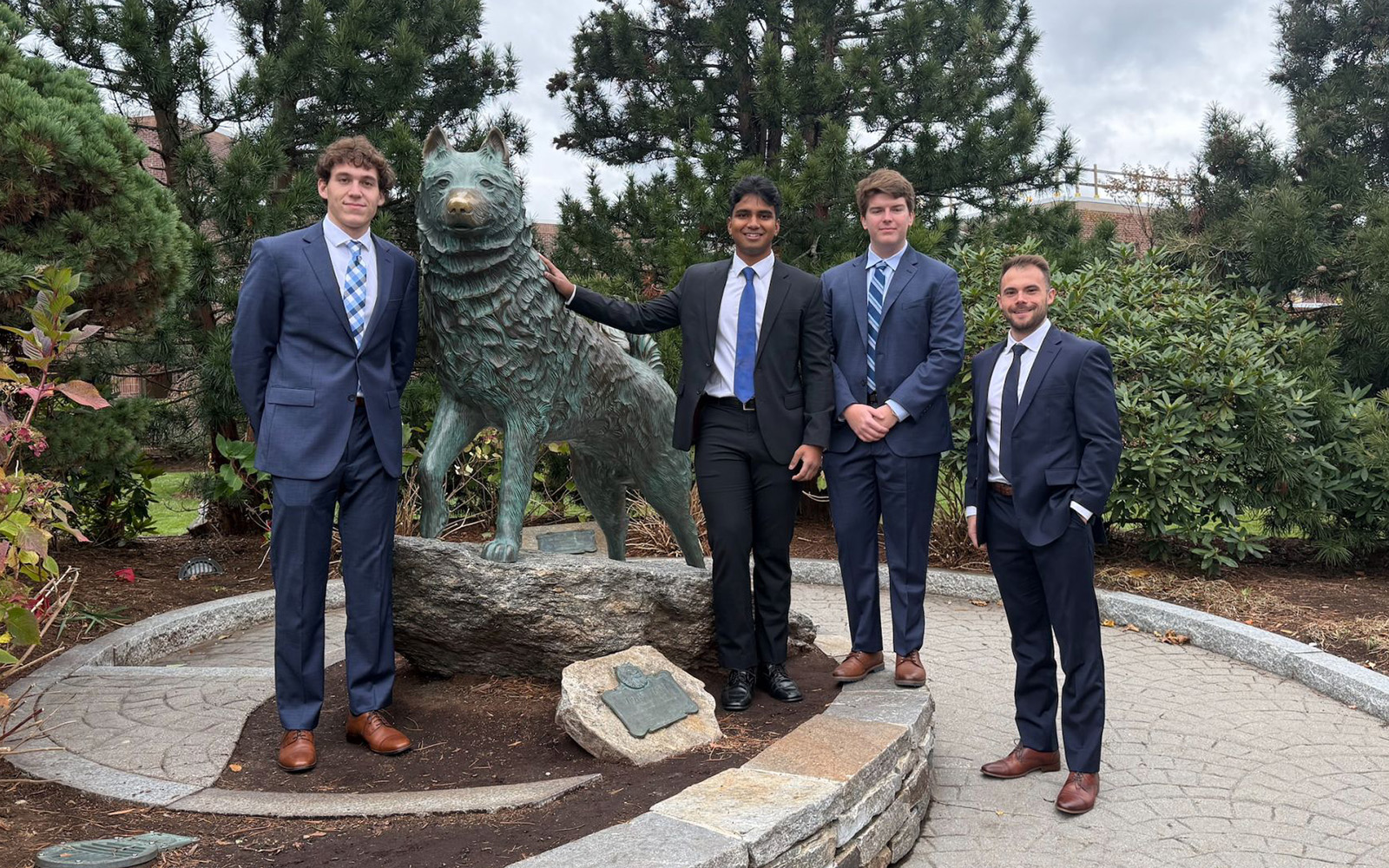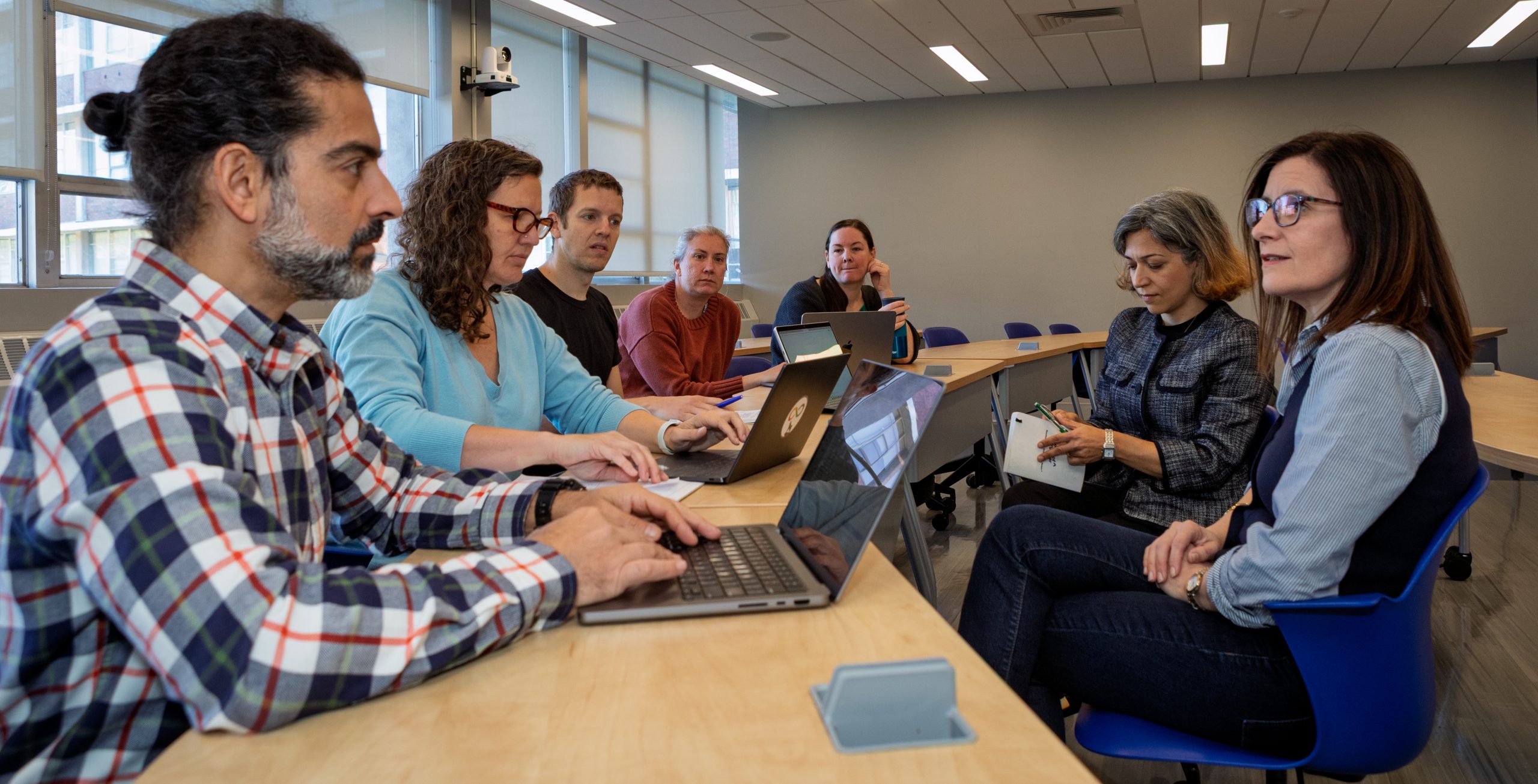By Brianna Diaz
 With a unique perspective that intertwines novel energy production with pollution prevention, Dr. Alexander Agrios is helping to transform the field of sustainable energy research. Dr. Agrios joined UConn’s Center for Clean Energy Engineering (C2E2) in the fall of 2009 as an assistant professor of environmental engineering within the Civil & Environmental Engineering Department. Hired under the state’s Eminent Faculty Initiative in Sustainable Energy, Dr. Agrios brings a holistic approach to sustainability in that environmental pollution can be prevented or mitigated through the development of innovative solar energy technologies.
With a unique perspective that intertwines novel energy production with pollution prevention, Dr. Alexander Agrios is helping to transform the field of sustainable energy research. Dr. Agrios joined UConn’s Center for Clean Energy Engineering (C2E2) in the fall of 2009 as an assistant professor of environmental engineering within the Civil & Environmental Engineering Department. Hired under the state’s Eminent Faculty Initiative in Sustainable Energy, Dr. Agrios brings a holistic approach to sustainability in that environmental pollution can be prevented or mitigated through the development of innovative solar energy technologies.
Dr. Agrios’ interest in energy began while he was a doctoral student at Northwestern University, where his research involved the use of nanoparticles in the photocatalytic treatment of certain environmental pollutants. During this time, Dr. Agrios discovered that researchers were using titanium dioxide nanoparticles — a material that he was using in his doctoral studies — to manufacture dye-sensitized solar cells.
This interest in solar energy propelled him into a five-year postdoctoral stint in Europe, thanks in part to an NSF International Research Fellowship Program award. After receiving his Ph.D. in 2003, Dr. Agrios proceeded through successive positions at École Centrale de Lyon in France, École Polytechnique Fédérale de Lausanne (EPFL) in Switzerland, and finally Uppsala University in Sweden.
During his stay in Switzerland, Dr. Agrios also had an opportunity to work with Professor Michael Grätzel, for whom the Grätzel cell is named. This cell, developed in the early 1990s by Grätzel and his associates, uses titanium dioxide nanoparticulates in conjunction with a photosensitized dye to convert sunlight into electrical energy. The opportunity to study with Grätzel, coupled with Dr. Agrios’ natural interest in European culture, provided him with vital educational experience. “It all came together well,” Agrios remarked. “I was interested in a field that had its genesis in Europe, which further fueled my desire to study there.”
Through his postdoctoral studies, Dr. Agrios gained a more comprehensive knowledge of the intricacies of solar cell technologies. Of the technologies currently on the market, the most efficient and widely used are mono or polycrystalline silicon-based solar cells. Crystalline solar cells are formed by combining positive- and negative-type semiconductors that are fused together through a doping process. These fused cells absorb light and send positive and negative charges in opposite directions; the separation of these charges creates an electric current.
One problem with using this method is that the silicon crystals must be very pure and thickly coated in order to both achieve a high photon capture rate and keep the two charges from combining and short-circuiting the system, which adds significantly to the production cost of this particular technology. In contrast, Dr. Agrios says, “Dye-sensitized solar cells offer a radically different way to collect solar energy compared to silicon-based solar cells — a major advantage being that they are produced using less expensive materials.”
Dye-sensitized solar cells consist of nanoparticles of titanium dioxide, which are very small semiconductors that provide a relatively large surface area upon which photosensitive dye is applied. These dye molecules absorb visible light and inject photo electrons into the nanoparticles. The charge separation occurs between the dye, the semiconductors and a liquid electrolyte in which the whole system is coated. Although this new method is somewhat less efficient, as the dye absorbs on average a narrower spectrum of light compared with its silicon counterparts, it is more than counterbalanced by reduced manufacturing cost.
Dr. Agrios’ current research focus is on boosting the efficiency of dye-sensitized solar cells by improving electron transport kinetics; he and his students are tackling this issue by both combining different semiconductors and by rerouting electrochemical reactions in order to circumvent certain energy loss processes. These projects are further helped by C2E2’s state-of-the-art equipment and a large number of research faculty engaged in energy research, some of whom are also engaged in work on nanoscale technologies. “We’re targeting our research on what I see as the main choke point of the cell,” Dr. Agrios said about his current research focus. “Solving these problems will provide the breakthrough that will lead to the next generation of higher-efficiency and lower cost dye sensitized solar cells.”
In addition to improving the efficiency of these new solar cell technologies, Dr. Agrios continues to stress the fundamental importance that energy research has on the field of environmental engineering. He is eager to develop graduate and undergraduate level courses that explore how nanoparticulate semiconductors can be used in pollution treatment, advanced energy conversion and energy storage. “Many of the pollution problems that we environmental engineers treat and try to remediate are a direct result of current energy practices and use,” he said. “I would like to work toward connecting the gaps between these fields.”
By Brianna Diaz
With a unique perspective that intertwines novel energy production with pollution prevention, Dr. Alexander Agrios is helping to transform the field of sustainable energy research. Dr. Agrios joined UConn’s Center for Clean Energy Engineering (C2E2) in the fall of 2009 as an assistant professor of environmental engineering within the Civil & Environmental Engineering Department. Hired under the state’s Eminent Faculty Initiative in Sustainable Energy, Dr. Agrios brings a holistic approach to sustainability in that environmental pollution can be prevented or mitigated through the development of innovative solar energy technologies.
Dr. Agrios’ interest in energy began while he was a doctoral student at Northwestern University, where his research involved the use of nanoparticles in the photocatalytic treatment of certain environmental pollutants. During this time, Dr. Agrios discovered that researchers were using titanium dioxide nanoparticles — a material that he was using in his doctoral studies — to manufacture dye-sensitized solar cells.
This interest in solar energy propelled him into a five-year postdoctoral stint in Europe, thanks in part to an NSF International Research Fellowship Program award. After receiving his Ph.D. in 2003, Dr. Agrios proceeded through successive positions at École Centrale de Lyon in France, École Polytechnique Fédérale de Lausanne (EPFL) in Switzerland, and finally Uppsala University in Sweden.
During his stay in Switzerland, Dr. Agrios also had an opportunity to work with Professor Michael Grätzel, for whom the Grätzel cell is named. This cell, developed in the early 1990s by Grätzel and his associates, uses titanium dioxide nanoparticulates in conjunction with a photosensitized dye to convert sunlight into electrical energy. The opportunity to study with Grätzel, coupled with Dr. Agrios’ natural interest in European culture, provided him with vital educational experience. “It all came together well,” Agrios remarked. “I was interested in a field that had its genesis in Europe, which further fueled my desire to study there.”
Through his postdoctoral studies, Dr. Agrios gained a more comprehensive knowledge of the intricacies of solar cell technologies. Of the technologies currently on the market, the most efficient and widely used are mono or polycrystalline silicon-based solar cells. Crystalline solar cells are formed by combining positive- and negative-type semiconductors that are fused together through a doping process. These fused cells absorb light and send positive and negative charges in opposite directions; the separation of these charges creates an electric current.
One problem with using this method is that the silicon crystals must be very pure and thickly coated in order to both achieve a high photon capture rate and keep the two charges from combining and short-circuiting the system, which adds significantly to the production cost of this particular technology. In contrast, Dr. Agrios says, “Dye-sensitized solar cells offer a radically different way to collect solar energy compared to silicon-based solar cells — a major advantage being that they are produced using less expensive materials.”
Dye-sensitized solar cells consist of nanoparticles of titanium dioxide, which are very small semiconductors that provide a relatively large surface area upon which photosensitive dye is applied. These dye molecules absorb visible light and inject photo electrons into the nanoparticles. The charge separation occurs between the dye, the semiconductors and a liquid electrolyte in which the whole system is coated. Although this new method is somewhat less efficient, as the dye absorbs on average a narrower spectrum of light compared with its silicon counterparts, it is more than counterbalanced by reduced manufacturing cost.
Dr. Agrios’ current research focus is on boosting the efficiency of dye-sensitized solar cells by improving electron transport kinetics; he and his students are tackling this issue by both combining different semiconductors and by rerouting electrochemical reactions in order to circumvent certain energy loss processes. These projects are further helped by C2E2’s state-of-the-art equipment and a large number of research faculty engaged in energy research, some of whom are also engaged in work on nanoscale technologies. “We’re targeting our research on what I see as the main choke point of the cell,” Dr. Agrios said about his current research focus. “Solving these problems will provide the breakthrough that will lead to the next generation of higher-efficiency and lower cost dye sensitized solar cells.”
In addition to improving the efficiency of these new solar cell technologies, Dr. Agrios continues to stress the fundamental importance that energy research has on the field of environmental engineering. He is eager to develop graduate and undergraduate level courses that explore how nanoparticulate semiconductors can be used in pollution treatment, advanced energy conversion and energy storage. “Many of the pollution problems that we environmental engineers treat and try to remediate are a direct result of current energy practices and use,” he said. “I would like to work toward connecting the gaps between these fields.”


